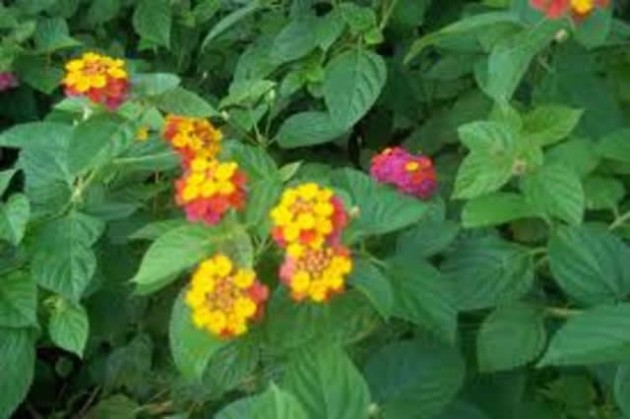Lantana Camara: An invasive menace

Sharon Ngomani
The shrubs web into an impenetrable thicket, presenting an invincible look. Branches intertwine into some nondescript, intricately grotesque art, leaving no space even for a mosquito to filter through. Underneath the shrubs is lifeless soil, condemned and cold – deprived of sunlight. Only hoarding ants are at beautiful home, leaving trails and heaps of soil here and there.The shrubs’ beautiful flowers; hues of purple, white, orange and like shades smile to the outraged sun which has been merciless to villagers, livestock and lifeless plants.
Somewhere in the meandering valleys of Danda village under Chief Ndanga in Zaka, a middle aged woman, Tsitsi Musiiwa, is infuriated.
“This is a war. Look, the field has been taken over by these invasive plants and I cannot stand by and watch,” she said.
Her stubby scarred fingers point to the expanse hedges of lantana camara which jealously guard her field while fiercely encroaching into it.
Lantana camara or Cherry pie is an invasive alien species, meaning it is a foreign element to our local ecosystems.
With its umbilical cord found in South America, it was introduced to Zimbabwe as part of cultural baggage during the colonial era around 1920.
Initially, it was used as a perimeter hedge for vegetable gardens and subsequently fields.
However, it spread, defying domestic use and eating into pasture lands, fields and forests.
Environmental Management Agency (EMA) corporate communications manager Mr Steady Kangata explains: “Lantana camara is now found throughout Zimbabwe because of seed dispersal. Its tiny seeds can be ferried by wind and germinate in another area. Or they can be eaten by birds, other animals and people and hence spread through deposits of bird droppings and other excretions,” he said.
Walking around Danda village, dominance of the plant was loud and stern. In clusters it weaved, conquered and suffocated other indigenous plants. It became the main and ultimate warrior in the Miombo turf, threatening the giants of Uapaca Kirkiana (muzhanje) and Brachystegia species (Msasa, mutondo).
“An invasive alien species like lantana camara colonises areas by killing our indigenous plants. This causes serious imbalance in the ecosystem as the food chain is tampered with,” explains Mr Kangata.
With more than 20 years of experience as an ecologist, Cuthbert Mutsiwegota, a lecturer at Midlands State University in the Department of Geography and Environmental studies (GES), says the effects of lantana camara on the environment are huge.
“Lantana camara reduces bio-diversity of both flora and fauna. This is because as it reduces diversity of plants, it also destroys habitats of birds, snakes, animals and rodents. Only a few species can survive in the shrubs of lantana camara,” he said
Effects of lantana camara can also be felt in the hierarchy of society. Dr Thomas Marambanyika, another lecturer in the GES Department, shed more light on the effects of lantana camara on food security.
“Lantana camara reduces arable and pasture land as it invades farming and grazing lands. This negatively affects productivity. Sometimes the plant just reduces the quality of the farming or grazing pastures,” he explained.
Due to the toxicity of the plant, livestock used to die after enjoying a delicacy of the ever-green leaves.
However, cases of such incidents are rarely reported nowadays. Both Mr Kangata and Dr Marambanyika attributed this to possibly developed resistance in the breeds or naturalization.
Many farmers in affected areas often talk about noticeable productivity decline on the areas surrounded by lantana camara. This is because the plant can reduce soil moisture and potassium content where it is intensified.
In 2007, Peter Chatanga studied the impact of lantana camara on native vegetation in northern Gonarezhou National park. He found that the invasive species had the capability of altering soil properties and native vegetation structure and composition to the detriment of wildlife management. In such a scenario, the effects can extend to reducing earnings in the tourism sector as wildlife and native vegetation are negatively affected.
However, the effects of the shrub on water sources are not yet fully known or documented. Death of fish due to its toxicity has been speculated upon where the plant favours riverine ecosystems.
In Zimbabwe, it is illegal for one to spread or fail to destroy an invasive species (listed on the fifth schedule of EMA Act Ch 20:27, 2007) on your property. Lantana camara is listed on part one of the fifth schedule. Despite this, many people are still adopting the shrub as a hedge. It may be out of ignorance.
To fight this menace, many organisations like EMA and Environment Africa are committing themselves to weed out the shrub. “EMA is working with communities in areas like Zvimba, Zaka and other areas trying to fight off Cherry pie. We engage them on mechanical removal of the weeds and burning the fully uprooted plants. Sometimes we employ herbicides though we don’t encourage their use as we do not want to pollute the environment with man-made toxins,” explained Mr Kangata.
If the plant is cut and not completely uprooted, the strong root system allows the birth of new healthier shoots.
Another option of dealing with the shrub is biological control where pathogens such as fungi and insects are introduced to weaken and reduce its survival in an ecosystem. Research is still going on but as anticipated is slowed down by incapacitation of the government.
A menace it maybe but why can’t we use the generously available shrub to our advantage? In India, communities have embarked on weaving and basketry projects where they use material from lantana camara to make baskets and other furniture elements such as chairs.
This is fast reducing the expanse of the weed at the same time providing a livelihood for people. Talk of double benefits.
Dr Marambanyika concurs with this idea.
“I think we need to invest in the research of the toxicity of Cherry pie so that we can use it to our advantage in the process of getting rid of it.
In Tugwi, Shurugwi, communities there are utilising residue or extract from lantana camara to kill insects and pests. This solution is sprayed on vegetables which drastically reduces damage from pests. Even after harvest, they use such solutions to reduce post harvest losses from insects. This is a good example of organic farming,” he said.
After walking around Danda I returned to check on Tsitsi Musiiwa. She was visibly tired; sweat streamed down her face, past her dry and chapped lips disappearing into her dirty blouse. She had done her best, digging up the plant. The dug out heap of lifeless lantana camara was consumed by a fiery fire. But she was nowhere closer to finishing off the vast expanses of stubborn and aggressive Cherry pie hedge eating into her field.












Comments